 W
WThe Battle of Bergen on 13 April 1759 saw the French army under de Broglie withstand an allied British, Hanoverian, Hessian, Brunswick army under Prince Ferdinand of Brunswick near Frankfurt-am-Main during the Seven Years' War.
 W
WThe Battle of Blenheim fought on 13 August [O.S. 2 August] 1704, was a major battle of the War of the Spanish Succession. The overwhelming Allied victory ensured the safety of Vienna from the Franco-Bavarian army, thus preventing the collapse of the reconstituted Grand Alliance.
 W
WThe Battle of Bound Brook was a surprise attack conducted by British and Hessian forces against a Continental Army outpost at Bound Brook, New Jersey during the American Revolutionary War. The British objective of capturing the entire garrison was not met, although prisoners were taken. The U.S. commander, Major General Benjamin Lincoln, left in great haste, abandoning papers and personal effects.
 W
WThe Battle of Brandywine, also known as the Battle of Brandywine Creek, was fought between the American Continental Army of General George Washington and the British Army of General Sir William Howe on September 11, 1777, as part of the American Revolutionary War (1775–1783). The forces met near Chadds Ford, Pennsylvania. More troops fought at Brandywine than any other battle of the American Revolution. It was also the second single-day battle of the war, after the Battle of Monmouth with continuous fighting for 11 hours.
 W
WThe siege of Cassel took place between October and November 1762, when an allied force of Hanoverian, Hessian and British troops under the command of the Duke of Brunswick besieged and captured the French-held town of Cassel. It was the final engagement of the Seven Years' War in Western Europe, as the conflict was brought to an end by the Peace of Paris the following year.
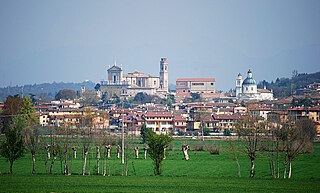 W
WThe Battle of Castiglione took place near Castiglione delle Stiviere in Lombardy, Italy on 8 September 1706 during the War of the Spanish Succession. A French army of 12,000 attacked a Hessian corps of 10,000 that was besieging the town, forcing them to retreat with heavy losses.
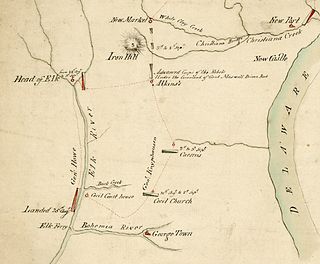 W
WThe Battle of Cooch's Bridge, also known as the Battle of Iron Hill, was a battle fought on September 3, 1777, between the Continental Army and American militia and primarily German soldiers serving alongside the British Army during the American Revolutionary War. It was the only significant military action during the war on the soil of Delaware, and it took place about a week before the major Battle of Brandywine. Some traditions claim this as the first battle which saw the U.S. flag.
 W
WThe Battle of Corbach, or Korbach, a Hanseatic town of Waldeck-Frankenberg in northern Hesse, Germany, was fought on 10 July 1760 during the Seven Years' War. Corbach was the first battle of the campaign of 1760 and was a victory for the French over the Hanoverians, the British and their allies.
 W
WThe Battle of Fort Washington was fought in New York on November 16, 1776 during the American Revolutionary War between the United States and Great Britain. It was a British victory that gained the surrender of the remnant of the garrison of Fort Washington near the north end of Manhattan Island. It was one of the worst Patriot defeats of the war.
 W
WThe Siege of Fort-Louis saw a force composed of Habsburg Austrians, Hessians and Bavarians led by Franz von Lauer lay siege to Fort-Louis which was held by a Republican French garrison under Michel Durand. The French capitulated after a defense lasting exactly one month. The siege occurred during the War of the First Coalition, part of the French Revolutionary Wars. In 1793 the fortress was sited on an island in the Rhine River, but today Fort-Louis is a village in the Bas-Rhin department in France.
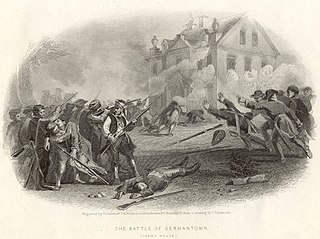 W
WThe Battle of Germantown was a major engagement in the Philadelphia campaign of the American Revolutionary War. It was fought on October 4, 1777, at Germantown, Pennsylvania, between the British Army led by Sir William Howe, and the American Continental Army, with the 2nd Canadian Regiment, under George Washington.
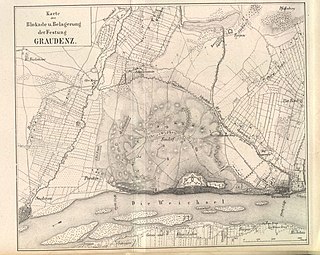 W
WThe Siege of Graudenz was a siege during the Napoleonic Wars between 22 January and 11 December, 1807. As part of the War of the Fourth Coalition the Prussian fortress at Graudenz in West Prussia was besieged by forces of the French Empire and its allies. The garrison, commanded by General Wilhelm René de l'Homme de Courbière, withheld blockade and siege for some 11 months, long past the formal Peace of Tilsit. The French abandoned the siege after the borders between Prussia and the new Duchy of Warsaw were defined; Graudenz staying a Prussian possession until after World War I.
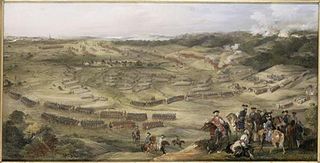 W
WThe Battle of Hastenbeck was fought as part of the Invasion of Hanover during the Seven Years' War between the allied forces of Hanover, Hesse-Kassel and Brunswick, and the French. The allies were defeated by the French army near Hamelin in the Electorate of Hanover.
 W
WThe Battle of Iron Works Hill, also known as the Battle of Mount Holly, was a series of minor skirmishes that took place on December 22 and 23, 1776, during the American War of Independence. They took place in Mount Holly, New Jersey, between an American force mostly composed of colonial militia under Colonel Samuel Griffin and a force of 2,000 Hessians and British regulars under Carl von Donop.
 W
WThe Landing at Kip's Bay was a British amphibious landing during the New York Campaign in the American Revolutionary War on September 15, 1776, occurring on the eastern shore of present-day Manhattan.
 W
WThe Battle of Kloster Kampen was a tactical French victory over a British and allied army in the Seven Years' War. The Allied forces were driven from the field.
 W
WThe Battle of Krefeld was a battle fought at Krefeld near the Rhine on 23 June 1758 between a Prussian-Hanoverian army and a French army during the Seven Years' War.
 W
WThe Battle of Limonest saw 30,000-53,000 Austrian and Hessian troops led by Prince Frederick of Hessen-Homburg defeat 20,000-23,000 French troops under Marshal Pierre Augereau.
 W
WThe Battle of Long Island, also known as the Battle of Brooklyn and the Battle of Brooklyn Heights, was an action of the American Revolutionary War fought on August 27, 1776, at the western edge of Long Island in the present-day Brooklyn, New York. The British defeated the Americans and gained access to the strategically important Port of New York, which they held for the rest of the war. It was the first major battle to take place after the United States declared its independence on July 4, and in troop deployment and combat, it was the biggest battle of the war.
 W
WIn the siege of Mainz, from 14 April to 23 July 1793, a coalition of Prussia, Austria, and other German states led by the Holy Roman Empire besieged and captured Mainz from revolutionary French forces. The allies, especially the Prussians, first tried negotiations, but this failed, and the bombardment of the city began on the night of 17 June.
 W
WThe Battle of Minden was a major engagement during the Seven Years' War, fought on 1 August 1759. An Anglo-German army under the overall command of Prussian Field Marshal Ferdinand of Brunswick defeated a French army commanded by Marshal of France, Marquis de Contades. Two years previously, the French had launched a successful invasion of Hanover and attempted to impose an unpopular treaty of peace upon the allied nations of Britain, Hanover and Prussia. After a Prussian victory at Rossbach, and under pressure from Frederick the Great and William Pitt, King George II disavowed the treaty. In 1758, the allies launched a counter-offensive against the French and Saxon forces and drove them back across the Rhine.
 W
WThe Siege of Nijmegen occurred from 27 October to 8 November 1794 during the Flanders campaign of the War of the First Coalition. It was the last major military confrontation between the forces of the Revolutionary French First Republic and the reactionary First Coalition of European monarchs including William V, Prince of Orange, before the fall of the Dutch Republic in January 1795, which William had ruled as hereditary stadtholder since 1751. As commander-in-chief of the Dutch States Army, his indecision, several changes of mind and lack of coordination with his Anglo-Hanoverian, Hessian, Prussian and Austrian allies contributed to the eventual surrender of Nijmegen to the French revolutionaries.
 W
WThe Battle of Pell's Point, also known as the Battle of Pelham, was a skirmish fought between British and American troops during the New York and New Jersey campaign of the American Revolutionary War. The conflict took place in what is now part of Pelham Bay Park in the Bronx, New York City and the towns of Pelham Manor and Pelham in Westchester County, New York.
 W
WThe Battle of Red Bank was a battle fought during the American Revolutionary War in which a British and Hessian force was sent to take Fort Mercer on the left bank of the Delaware River just south of Philadelphia, but was decisively defeated by a far inferior force of Colonial defenders. Although the British did take Fort Mercer a month later, the victory supplied a sorely-needed morale boost to the American cause, delayed British plans to consolidate gains in Philadelphia, and relieved pressure on General George Washington's army to the north of the city.
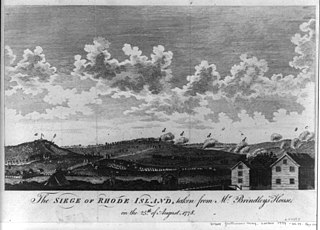 W
WThe Battle of Rhode Island took place on August 29, 1778. Continental Army and militia forces under the command of General John Sullivan had been besieging the British forces in Newport, Rhode Island, which is situated on Aquidneck Island, but they had finally abandoned their siege and were withdrawing to the northern part of the island. The British forces then sortied, supported by recently arrived Royal Navy ships, and they attacked the retreating Americans. The battle ended inconclusively, but the Continental forces withdrew to the mainland and left Aquidneck Island in British hands.
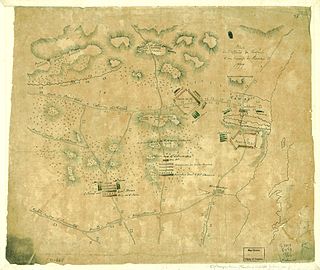 W
WThe Battle of Short Hills was a conflict between a Continental Army force commanded by Brigadier General William Alexander, and an opposing British force commanded by Lieutenant General William Howe. The battle took place on June 26, 1777, at Scotch Plains and Edison, New Jersey, during the American Revolutionary War. Despite the name, no fighting occurred in modern-day Short Hills, a section of Millburn.
 W
WThe siege of Cassel was a failed attempt by Duke Ferdinand of Brunswick to capture French-held Kassel, the capital of Hesse-Kassel. Brunswick lifted the siege after forces of the Duc de Broglie inflicted heavy casualties on his forces at the Battle of Grünberg, making continuation of the siege untenable.
 W
WThe Battle of Spencer's Ordinary was an inconclusive skirmish that took place on 26 June 1781, late in the American Revolutionary War. British forces under Lieutenant Colonel John Graves Simcoe and American forces under Colonel Richard Butler, light detachments from the armies of General Lord Cornwallis and the Marquis de Lafayette respectively, clashed near a tavern at a road intersection not far from Williamsburg, Virginia.
 W
WThe Battle of Speyerbach took place on 15 November 1703 in the War of the Spanish Succession. A French army besieging Landau surprised and defeated a German relief army near Speyer.
 W
WThe Battle of Springfield was fought during the American Revolutionary War on June 23, 1780, in Essex County, New Jersey. After the Battle of Connecticut Farms, on June 7, 1780, had foiled Lieutenant General Wilhelm, Baron von Knyphausen’s expedition to attack General George Washington’s army at Morristown, New Jersey, Knyphausen and Lieutenant General Sir Henry Clinton, British commander-in-chief in North America, decided upon a second attempt. Although the British were initially able to advance, they were ultimately forced to withdraw in the face of newly arriving rebel forces, resulting in a Continental victory. The battle effectively ended British ambitions in New Jersey.
 W
WThe Battle of Trenton was a small but pivotal American Revolutionary War battle that took place on the morning of December 26, 1776, in Trenton, New Jersey. After General George Washington's crossing of the Delaware River north of Trenton the previous night, Washington led the main body of the Continental Army against Hessian auxiliaries garrisoned at Trenton. After a brief battle, almost two-thirds of the Hessian force was captured, with negligible losses to the Americans. The battle significantly boosted the Continental Army's waning morale, and inspired re-enlistments.
 W
WThe Battle of Warburg was a battle fought on 31 July 1760 during the Seven Years' War. The Battle was a victory for the Hanoverians and the British against the French. British general John Manners, Marquess of Granby achieved some fame for charging at the head of the British cavalry and losing his hat and wig during the charge. The French lost 1500 men, killed and wounded, around 2,000 prisoners and ten pieces of artillery.
 W
WThe Battle of White Marsh or Battle of Edge Hill was a battle of the Philadelphia campaign of the American Revolutionary War fought December 5–8, 1777, in the area surrounding Whitemarsh Township, Pennsylvania. The battle, which took the form of a series of skirmish actions, was the last major engagement of 1777 between British and American forces.
 W
WThe Battle of White Plains was a battle in the New York and New Jersey campaign of the American Revolutionary War fought on October 28, 1776, near White Plains, New York. Following the retreat of George Washington's Continental Army northward from New York City, British General William Howe landed troops in Westchester County, intending to cut off Washington's escape route. Alerted to this move, Washington retreated farther, establishing a position in the village of White Plains but failed to establish firm control over local high ground. Howe's troops drove Washington's troops from a hill near the village; following this loss, Washington ordered the Americans to retreat farther north.
 W
WThe Battle of Wilhelmsthal was fought on 24 June 1762 during the Seven Years' War between the allied forces of Britain, Prussia, Hanover, Brunswick and Hesse under the command of the Duke of Brunswick against France. Once again, the French threatened Hanover, so the Allies manoeuvered around the French, surrounded the invasion force, and forced them to retreat. It was the last major action fought by Brunswick's force before the Peace of Paris brought an end to the war.
 W
WThe Siege of Ypres saw a Republican French army commanded by Jean-Charles Pichegru invest the fortress of Ypres and its 7,000-man garrison composed of Habsburg Austrians under Paul von Salis and Hessians led by Heinrich von Borcke and Georg von Lengerke. French troops under Joseph Souham fended off three relief attempts by the corps of François Sébastien Charles Joseph de Croix, Count of Clerfayt. Meanwhile, the French besiegers led by Jean Victor Marie Moreau compelled the Coalition defenders to surrender the city. The fighting occurred during the War of the First Coalition, part of the Wars of the French Revolution. In 1794 Ypres was part of the Austrian Netherlands, but today it is a municipality in Belgium, located about 120 kilometres (75 mi) west of Brussels.